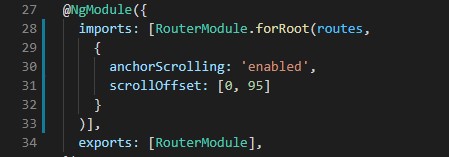
Laravel Observers
April 26, 2021
Dynamic Doughnut Graph Using Laravel Vue Component
May 24, 2021
I've been fortunate enough to dev with Angular for the last 2 years, and I'm always pleasantly surprised when the framework makes my life easier with build in methods or configurations.
One such configuration set is the Router ExtraOptions configurations. These are applied to the Router Module and I'm going to go through a few that I have used and found very helpful.
Jumping to Anchor Tags
If you want the user to jump to a specific place on a page, add the anchorScrolling property to the .forRoot method in your routing module file, like so:

then in your view, reference your page you would like to route to and specify the fragment (#) part you want to append to your URL using the fragment attribute:

and lastly give the section you want to scroll to an id (the same name as your fragment above), and that's it. Angular will jump to the exact spot you specified. Best of all the fragment attribute also accepts component variables so changing the name connected to the fragment programmatically is no problem (reference the variable using string interpolation).
Next you would most likely want to set an offset when jumping to an anchor tag. This we do next.
Adding a Scroll offset
If you find your div is partially disappearing behind a fixed header, you might want to add an offset to the top of the page when scrolling to an anchor. This can sometimes be tricky with css and not work as well as expected. Here the scrollOffset property works quick and easy:

Now each time you jump to an anchor tag it will not be cut off by a fixed header or navigation bar. The two values in the array are the x and y axis values, In this example I've giving it an offset of 95px from the top of the page.
Restoring the page scroll position
In older versions of Angular, like version 8, this configuration is not enabled by default. In the case that you are using that version or older, simply adding the scrollPositionRestoration property to your route configuration will force the page to shoot back to the top every time a user navigates backwards.

In cases where the user might constantly be presented with the bottom or middle of a page when navigating back, this simple solution might save you a small headache and the user a lot of frustration.
Reloading the same URL
If you have a situation where you want the page to reload when the same URL is provided to the browser (by default Angular ignores reloading the same URL), Angular has you covered. Sometimes reloading the same page is necessary because you might want to invoke your ngOninit method in order to trigger a refresh feature.
Adding the onSameUrlNavigation property will force the framework to reload the page for you in turn running your logic.

I hope some of these awesome properties will help you in the future, it certainly has for me.








2 Comments
Wow as an experienced Angular Dev, I have defiantly found this interesting.
Thank you Mitch, glad you found this interesting!